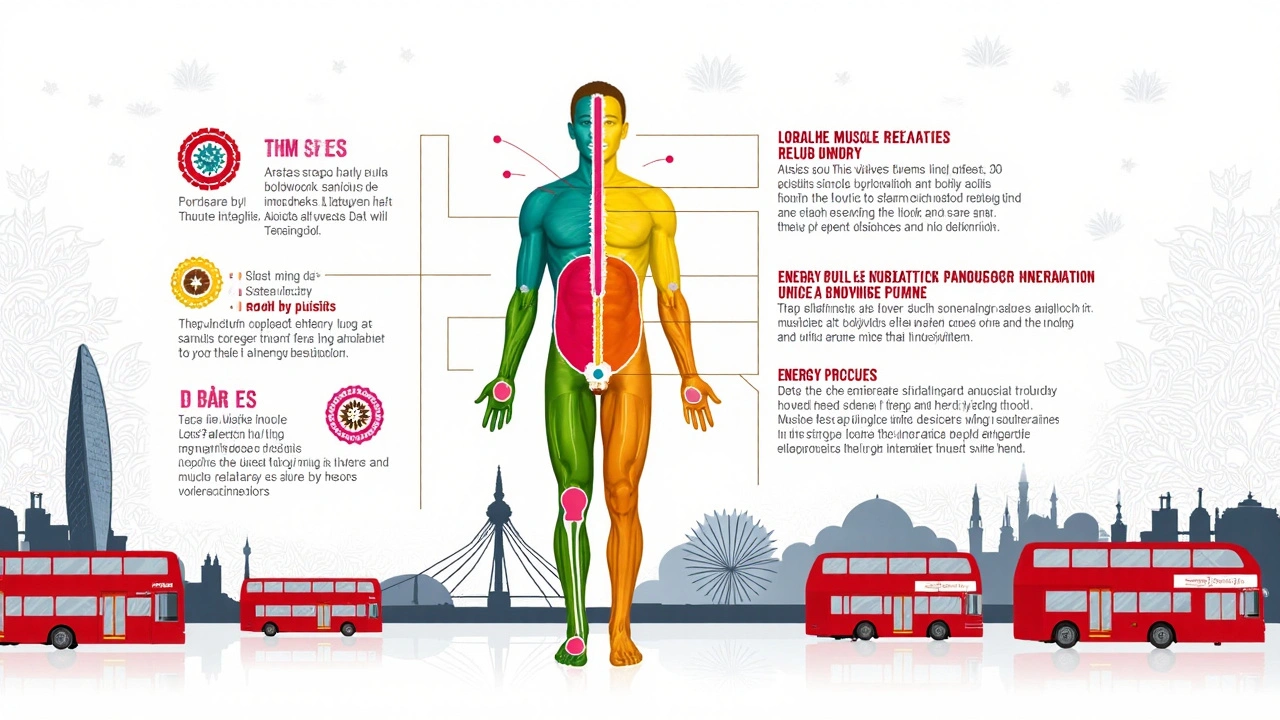Thai Massage London: The Healing Touch You Didn't Know You Needed

Ever felt like your regular massage just isn’t cutting it anymore? Londoners are swapping deep tissue and Swedish for something with a little more oomph—Thai massage. It’s not just about relaxation. People book sessions because they want to feel their bodies actually change: less pain, more mobility, better sleep, and even a clearer mind.
If you’ve walked past a place advertising Thai massage and wondered what the fuss is about, you’re not alone. This isn’t your run-of-the-mill back rub. Think gentle yoga stretches mixed with massage—except you’re not doing the hard work; a skilled therapist does it for you. That’s a relief if you’re not exactly flexible. But what makes it so special in a city as whirl-windy as London? For starters, it tackles issues office workers and busy parents know too well: stiff necks, tight shoulders, tension headaches. It’s also one of the few massage styles where you keep your clothes on, so no awkward moments on the massage bed.
Curious if there’s real science behind it? Research shows Thai massage can lower stress, improve flexibility, and help manage chronic pain. Not bad for something invented over 2,000 years ago. Ready to learn what happens during a session and how to find a legit spot in London? You’re in the right place.
- The Roots and Rise of Thai Massage
- What Happens During a Thai Massage Session?
- Real Benefits: From Stiff Bodies to Stressed Minds
- Who Should (and Shouldn’t) Try Thai Massage in London?
The Roots and Rise of Thai Massage
Long before anyone in London ever booked a session, Thai massage was already a huge deal in Southeast Asia. It’s actually one of the world’s oldest systems of bodywork, going back about 2,500 years. While it started in Thailand, the core ideas mix local traditions with influences from India and China. Some people call it “Thai yoga massage” because it uses a combo of stretches, pressure points, and rhythmic movements. The legend says a doctor named Jivaka Kumar Bhaccha, who was actually Buddha’s physician, kicked it all off.
Fast forward a few centuries, and you’ll find Thai massage everywhere in Thailand—on street corners, beaches, and even big city hospitals. In fact, it’s so important there that UNESCO added “Traditional Thai Massage” to its Intangible Cultural Heritage list in 2019. That put it on the map as a globally recognized therapy.
As people started traveling more, they wanted to take those feel-good benefits home. That’s how Thai massage landed in places like London. And it’s not just a “trendy” thing—there are now hundreds of Thai massage clinics across the city. A lot of them are actually run by Thais who trained in well-known schools such as Wat Pho in Bangkok, which only adds to the authenticity.
If you’re wondering why it’s suddenly everywhere, the numbers give a clue. Massage therapy overall has boomed in the UK. Check out how the market has grown:
| Year | UK Massage Clinics |
|---|---|
| 2015 | 4,800 |
| 2020 | 7,100 |
| 2024 | 8,600 |
Out of these, a big share now offer Thai massage—with London leading the charge. People like it because it’s hands-on, gets results, and can fit right into a busy schedule. Plus, as more folks started focusing on wellness, the demand for authentic therapies just blew up.
So, that’s how thai massage london shot from ancient tradition to an everyday fix for stressed-out city life. Pretty wild how something with such deep roots is now a go-to for people who spend more time behind screens than in temple courtyards.
What Happens During a Thai Massage Session?
First up, you’ll usually keep your comfy clothes on—no need to get undressed, which can be a huge relief if you’re new to the scene or just don’t love the idea of stripping down. A real Thai massage isn’t just a rubdown. It’s more like yoga for lazy people, with the therapist doing the stretching and moving for you. Most sessions happen on a thick mat on the floor, not a table, giving plenty of space for bending and stretching.
The therapist starts by pressing and rocking your body along energy lines, which are called “Sen.” Don’t worry, this isn’t painful (it actually feels pretty great once you’re into it). They’ll use their hands, elbows, knees, and sometimes even feet to apply pressure and move you through stretches. Here’s what a typical session in thai massage london looks like:
- You lie down fully clothed on a mat
- The therapist checks if you have any pain or injuries to avoid those areas
- They begin at your feet and work up to your head, using slow rhythmic pressure
- They gently stretch out your arms, legs, and spine, using their own body as leverage
- Expect some twists, pulls, and compressed holds—it’s interactive, so don’t be shy about speaking up
Most sessions last about 60 to 90 minutes. Some studios in London combine Thai massage with warm herbal compresses, especially for muscle soreness or to add a relaxing effect. Wondering what makes it different from a spa massage?
| Thai Massage | Typical Western Massage |
|---|---|
| Fully clothed, on a mat | Usually undressed, on a table |
| Stretching and rocking motions | Mostly kneading and stroking |
| Therapist uses hands, elbows, knees, feet | Mostly hands and arms only |
Another thing: Don’t plan anything strenuous after your first real Thai massage. Many people feel light, stretched out, and a little woozy (in a good way). If you haven’t tried it yet, just come in with an open mind, tell your therapist your comfort level, and let them do their thing. Most clients walk out wishing they tried it years ago.

Real Benefits: From Stiff Bodies to Stressed Minds
People rave about Thai massage not just for the feel-good effects but because it works on stuff nobody talks about—think constant shoulder knots or that anxiety that just won’t quit. Unlike regular massages that mostly knead muscles, Thai massage uses stretches, pressure points, and joint movements to give results that stick. Here’s what actually happens when you book that session in London:
- Flexibility Boost: All those stretches your therapist does for you? They actually help your muscles, joints, and tendons loosen up without you having to commit to awkward yoga poses. You might walk out feeling taller or noticing you can turn your neck easier.
- Stress Buster: A study from Thailand’s Mahidol University found regular Thai massage sessions significantly lowered stress levels after just a few weeks. People felt calmer and less wound up, which is rare for city life.
- Pain Relief: If you’re hunched over a laptop all day, you know about lower back pain. Thai massage is known for reducing pain in the lower back, shoulders, and neck—even among people who’ve had pain for years.
- Better Sleep: Feeling tired but struggle to actually sleep? Clients have reported deeper sleep after a Thai massage, probably because the body relaxes so much during the treatment.
Check out this quick info snapshot—real studies, not hype:
| Benefit | What Happens? | Evidence/Source |
|---|---|---|
| Pain Reduction | Less muscle stiffness and soreness | 2015 study by Mahidol University: 60% saw pain drop after 2 weeks |
| Stress Relief | Lower heart rate and cortisol (stress hormone) | 2017 International Journal of Neuroscience: measurable cortisol drop post-massage |
| Flexibility | Better range of movement | 2013 Journal of Bodywork & Movement Therapies: improved flexibility up to 20% in 4 weeks |
| Improved Sleep | Better sleep quality and duration | Client reports and small clinical trials (2019, Sleep Medicine Journal) |
Now, let’s be clear. Not everyone will see the same benefits instantly, but if you stick with it, that stacked-up tension from work, commutes, and laptop marathons won’t stand much of a chance. Your next thai massage london session just might surprise you.
Who Should (and Shouldn’t) Try Thai Massage in London?
Not sure if thai massage london is right for you? It helps to know what this treatment actually does to your body before you book a session. Thai massage involves guided stretches, firm pressing, and some deep muscle work. It’s way more active than most Western massages, so the experience isn’t for everyone.
The best candidates for Thai massage are folks looking for relief from muscle stiffness, limited mobility, or plain old stress. People who work at desks, athletes, and those dealing with chronic back or neck tension often see real improvements. If you’re struggling with headaches or trouble sleeping, therapists in London say clients routinely report better rest and less pain after a series of sessions.
That said, certain groups should take extra care. If you fall into any of these categories, it’s smart to check with your GP or talk openly with your massage therapist:
- Pregnant women—especially in the first trimester or with complicated pregnancies
- People with recent surgery, broken bones, or severe osteoporosis
- If you have uncontrolled high blood pressure, heart trouble, or a history of blood clots
- Anyone recovering from open wounds or infections
Good therapists in London always ask about your health first, and they can usually adapt the session to be safer for your condition—but honesty is key. Here’s a quick cheat sheet for who should and shouldn’t get Thai massage right now:
| Best Candidates | Should Avoid |
|---|---|
| Desk workers with tight backs/necks | People with recent surgeries or fractures |
| Busy parents needing stress relief | Pregnant women in first trimester |
| Recreational athletes or gym lovers | Severe osteoporosis sufferers |
| People with sleep or tension headaches | Anyone with infections or open wounds |
| Folks with chronic low back pain | Uncontrolled hypertension or heart issues |
Here’s another tip: if you have specific pain, tell your therapist upfront. A proper Thai massage shouldn’t leave you limping or bruised. Most London spots will adjust pressure and stretches, so don’t hesitate to speak up. And if you’re brand new, start with a shorter introductory session—just to see how your body reacts. Always listen to your gut and stop right away if anything feels wrong. Safety first, always.



